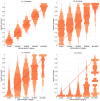Admixture in Latin America: geographic structure, phenotypic diversity and self-perception of ancestry based on 7,342 individuals
- PMID: 25254375
- PMCID: PMC4177621
- DOI: 10.1371/journal.pgen.1004572
Admixture in Latin America: geographic structure, phenotypic diversity and self-perception of ancestry based on 7,342 individuals
Abstract
The current genetic makeup of Latin America has been shaped by a history of extensive admixture between Africans, Europeans and Native Americans, a process taking place within the context of extensive geographic and social stratification. We estimated individual ancestry proportions in a sample of 7,342 subjects ascertained in five countries (Brazil, Chile, Colombia, México and Perú). These individuals were also characterized for a range of physical appearance traits and for self-perception of ancestry. The geographic distribution of admixture proportions in this sample reveals extensive population structure, illustrating the continuing impact of demographic history on the genetic diversity of Latin America. Significant ancestry effects were detected for most phenotypes studied. However, ancestry generally explains only a modest proportion of total phenotypic variation. Genetically estimated and self-perceived ancestry correlate significantly, but certain physical attributes have a strong impact on self-perception and bias self-perception of ancestry relative to genetically estimated ancestry.
Conflict of interest statement
The authors have declared that no competing interests exist.
Figures



References
-
- Sturm RA (2009) Molecular genetics of human pigmentation diversity. Hum Mol Genet 18: R9–17. - PubMed
-
- Jacobs LC, Wollstein A, Lao O, Hofman A, Klaver CC, et al. (2013) Comprehensive candidate gene study highlights UGT1A and BNC2 as new genes determining continuous skin color variation in Europeans. Hum Genet 132: 147–158. - PubMed
-
- Morner M (1967) Race Mixture in the History of Latin America. Little Brown & Company. 178 p.
Publication types
MeSH terms
Grants and funding
LinkOut - more resources
Full Text Sources
Other Literature Sources

